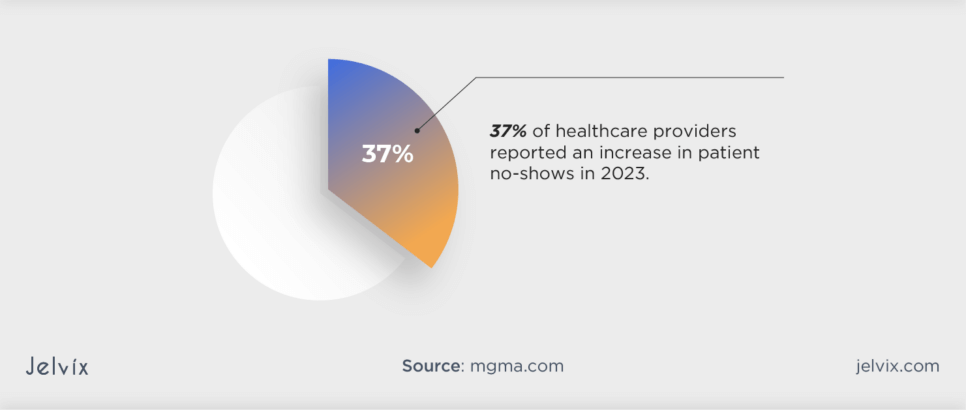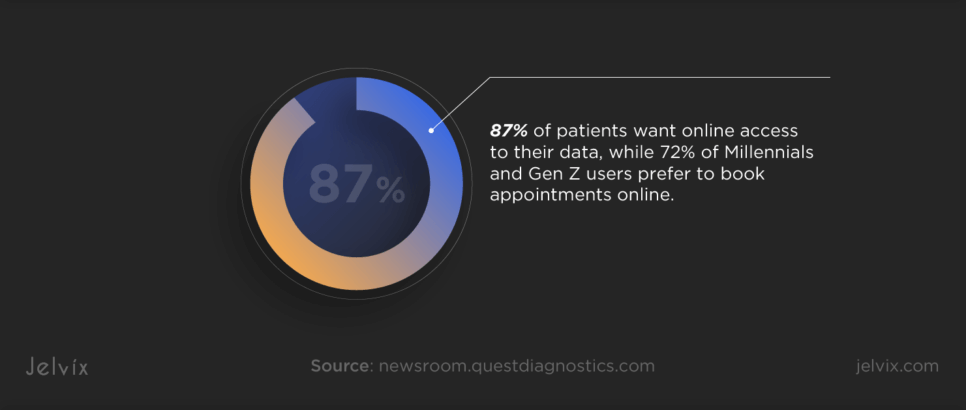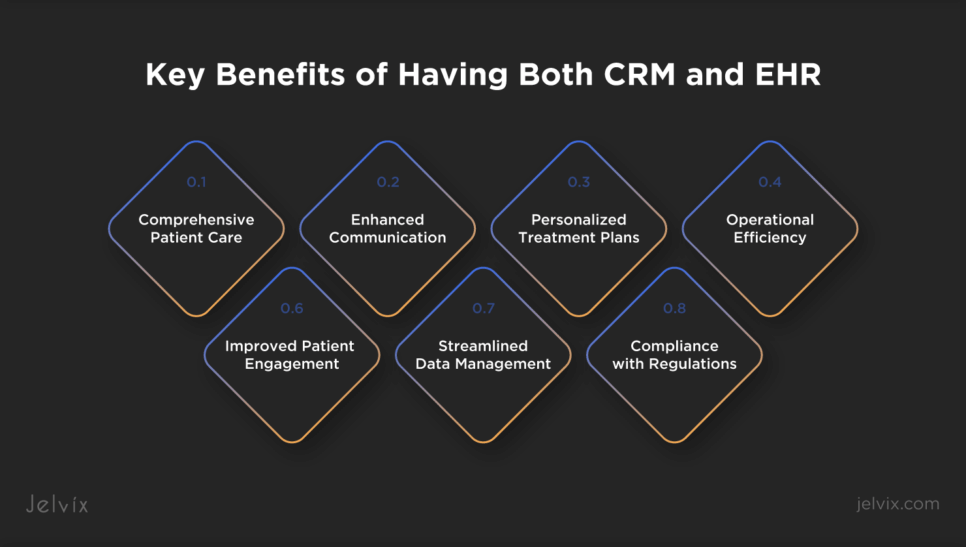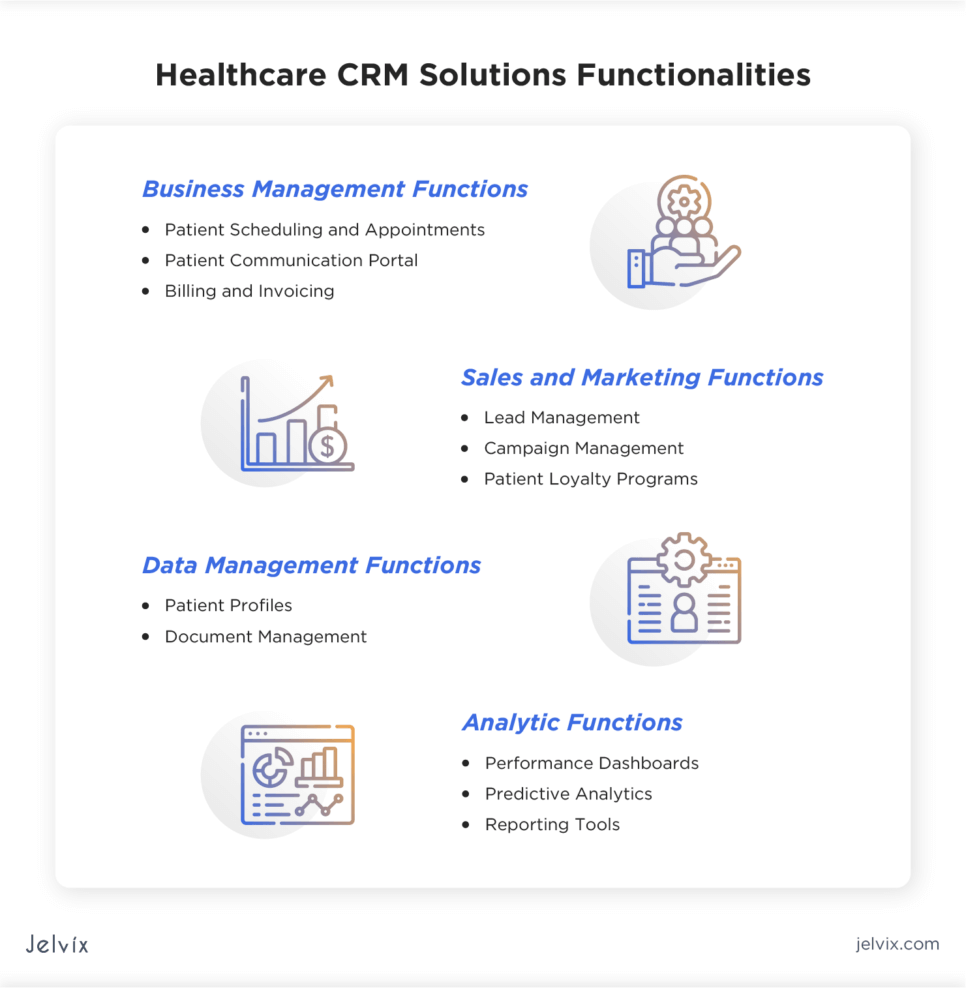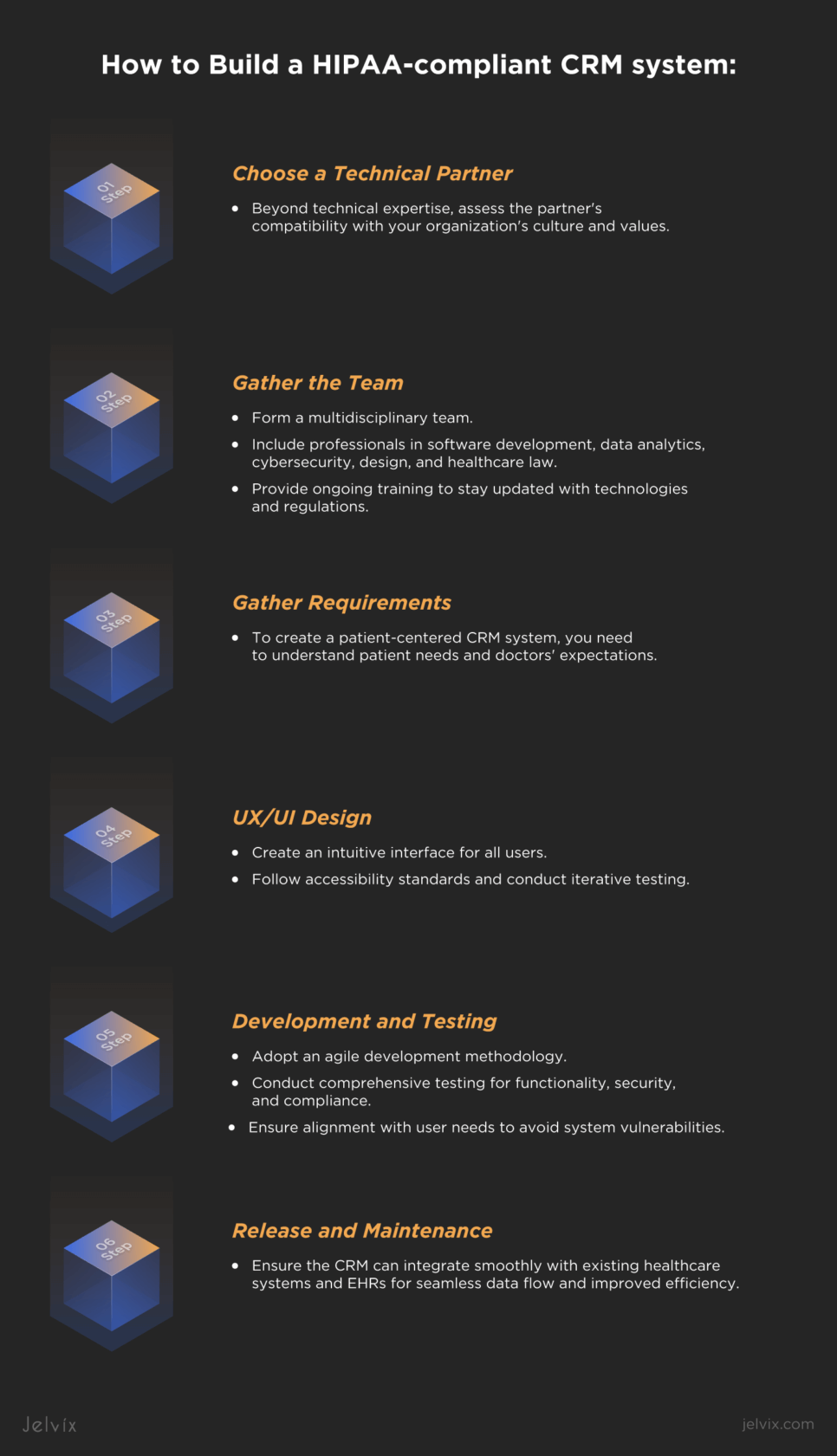As patients become more demanding, many healthcare providers experience challenges in managing clear communication with them. 37% of healthcare providers reported an increase in patient no-shows in 2023. Adopting a CRM system becomes a strategic solution to enable more effective communication and appointment management strategies.
However, building custom CRM that is safe to use and compliant with industry regulations poses a challenge that requires specific expertise to resolve.
If you want to create a custom, HIPAA-compliant, and feature-rich CRM system, read this guide. You will find out how to choose a cloud-based solution, focusing on key features and benefits, while following a step-by-step approach.
Healthcare CRM Market Stats
The healthcare CRM market has shown remarkable growth, reflecting the sector’s increasing reliance on technology to manage patient care and operational efficiency. In 2021, the market size was valued at USD 14.3 billion and is projected to expand at a compound annual growth rate of 8.4% by 2030.
Studies report that 87% of patients want online access to their data, while 72% of Millennials and Gen Z users prefer to book appointments online. As a result, clinics experience the rising demand for structured data and automation tools, pushing hospital managers to integrate digital solutions, including CRM systems, into their medical environment.
Global Geographical CRM Market Structure
The CRM market is experiencing significant growth globally, driven by the increasing adoption of healthcare solutions, the demand for patient engagement tools, and the emphasis on improving patient outcomes.
As of the AWS report, North America leads as the largest market, primarily due to advanced healthcare infrastructure, with the United States and Canada being key contributors. Europe follows, with the United Kingdom, Germany, and France driving the market.
The Asia Pacific region is marked by the fastest growth, led by China, India, and Japan, thanks to rising healthcare expenses and demand for medical solutions. Latin America, with Brazil and Mexico at the forefront, and the Middle East and Africa, led by Saudi Arabia and the UAE, are emerging markets, showing significant growth.
Healthcare CRM vs EHR: Key Differences
Although both CRM and EHRs serve to facilitate patient care, they provide different functionalities that benefit doctors and patients in different ways.
Electronic health record (EHR) systems are designed to digitalize patient health records, providing a comprehensive and accessible health information database. They focus on the clinical aspects of patient care, including medical history, diagnoses, medications, treatment plans, and test results.
In contrast, a healthcare customer relationship management system (CRM) focuses on managing and improving patient relationships, streamlining communication, and facilitating patient engagement initiatives. It is designed to capture and use patient data to support marketing, customer service, and patient outreach, enhancing the overall patient experience.
While EHRs are centered on clinical data and healthcare delivery, CRMs focus on the administrative and relationship aspects, helping healthcare organizations to understand and communicate with their patients more effectively. Integrating CRM and EHR systems can be a good idea, as this synergy offers a more holistic view of patient interactions, from clinical care to post-treatment engagement, enabling personalized care and efficient service delivery.
Discover how to enhance patient experience with CRM-EHR integration. Explore benefits, challenges, and crucial insights for optimizing healthcare operations.
Why Your Business Needs Healthcare CRM Software
A medical CRM system is a powerful tool that can transform healthcare delivery and management. It supports improved patient support services, enables personalization of care, and drives time and cost efficiencies.
Improved Patient Support
A medical CRM system streamlines patient communication and management, facilitating timely support, appointment scheduling, and feedback collection. This leads to increased patient satisfaction by ensuring patients feel valued and well-supported.
Personalization
Medical CRM systems provide the tools to deliver personalized care and communication. By analyzing patient data, doctors can tailor treatment plans to meet individual patient needs, preferences, and health conditions. Tailored health tips, reminders, and wellness recommendations increase patient engagement and improve healthcare outcomes.
Time and Cost Optimization
Automating routine administrative tasks saves significant time for physicians and reduces costs to clinics. A CRM system enhances operational efficiency, allowing for better resource allocation and reduced time waste, ultimately improving the quality of care.
The Smart Way to Choose – Download Your Guide to Selecting the Right Healthcare Tech Partner!

Healthcare CRM Solutions: Feature Breakdown
Developing a cloud-based and safe CRM system involves integrating features that enhance clinical operations, help manage patient data efficiently, and provide valuable insights into health conditions through analytics. By selecting functionalities that align with your healthcare organization’s needs, you can create a powerful solution that enhances overall clinical performance and patient satisfaction.
Business Management Functions
Business management functions in a healthcare CRM system focus on optimizing operational efficiency and enhancing patient care through streamlined processes. These features are designed to manage the day-to-day administrative and clinical tasks more effectively.
Patient Scheduling and Appointments
These tools serve to automate the scheduling process, allowing patients to book, reschedule, or cancel appointments through the CRM. Integration with the clinic’s calendars and telehealth solutions can help ensure optimal appointment management and reduce no-shows.
Patient Communication Portal
Patient portals are tools that facilitate secure and HIPAA-compliant communication channels for patients to contact doctors directly. Features can include secure messaging, notifications, and automated reminders for appointments or medication adherence.
Billing and Invoicing
Billing tools help streamline the billing process with automated invoicing, payment tracking, and integration with insurance providers. This reduces the administrative burden on staff, improves financial accuracy, and prevents a clinic from getting fined.
Sales and Marketing Functions
Sales and marketing features aim to attract new patients and retain existing ones by leveraging data-driven insights to tailor marketing efforts and manage patient relationships effectively.
Lead Management
Lead management tools help track potential patients from their first interaction, allowing for personalized follow-up and engagement strategies. This feature helps in identifying and nurturing leads to improve conversion rates.
Campaign Management
This feature enables the creation, execution, and analysis of marketing campaigns within the CRM. It allows healthcare organizations to target specific patient demographics, measure the effectiveness of marketing efforts, and adjust strategies in real time.
Patient Loyalty Programs
These tools manage programs designed to reward patients for repeat visits or referrals. By offering personalized rewards, this feature helps increase patient loyalty and contributes to long-term relationships.
Data Management Functions
Data management features centralize and organize patient data, ensuring secure and easy access to information that supports clinical decisions and patient care planning.
Patient Profiles
You can create comprehensive profiles that include medical history, contact information, and interaction logs. This feature ensures that healthcare pros have quick access to vital patient information, facilitating personalized care.
Document Management
Document management provides a secure system for managing and storing patient documents such as test results, medical images, and treatment plans. Features include version control, secure sharing, and compliance with data protection regulations like HIPAA.
Analytic Functions
Analytic functions in a healthcare CRM system harness data to provide insights into operational efficiency, patient care quality, and business growth strategies. These functionalities empower healthcare organizations with the information needed for informed decision-making and strategic planning.
Performance Dashboards
They offer real-time and customizable views of key performance indicators (KPIs), such as patient satisfaction levels, appointment utilization rates, and revenue cycles. These dashboards allow healthcare administrators to monitor operational health at a glance and make timely adjustments.
Predictive Analytics
It uses historical patient data and interaction patterns to predict future healthcare trends, patient behaviors, and outcomes. This feature aids in proactive patient care planning, resource allocation, and identifying potential areas for service expansion or improvement.
Reporting Tools
Reporting tools help generate comprehensive reports on a wide range of metrics, including clinical outcomes, financial performance, and patient demographics. These tools are essential for evaluating the effectiveness of healthcare services, compliance with regulatory standards, and identifying opportunities for cost savings and efficiency improvements.
6 Steps To Build a HIPAA-Compliant CRM System
Building a custom healthcare CRM system is complex but it can significantly enhance the efficiency of healthcare organizations and improve relations with patients. The development process involves a series of strategic steps, from choosing the right technical partner to the system’s release and ongoing maintenance.
By following these steps and focusing on the unique needs of your healthcare entity, you can develop a CRM that not only meets current requirements but also adapts to future challenges and opportunities in the healthcare sector.
Step 1. Choosing a Technical Partner
A good partnership is based on mutual understanding and shared goals. Beyond technical expertise, assess the partner’s compatibility with your organization’s culture and values. Note that choosing the wrong software development partner can lead to a product that fails to meet regulatory standards and user needs, causing project delays and additional costs.
Step 2. Gathering the Team
Medical CRM development requires forming a multidisciplinary team. Include professionals with skills in software development, data analytics, cybersecurity, design, and healthcare law to cover all bases of CRM functionalities and compliance. Ensure ongoing training to stay current with technologies and regulations, keeping the CRM system up-to-date and compliant.
Step 3. Gathering Requirements
This stage focuses on collecting feedback to identify key functionalities for enhancing patient care and operational efficiency. You need to understand patient needs and doctors’ expectations to create a patient-centered CRM system. Use interviews, focus groups, and surveys to ensure no critical user needs are missed.
Step 4. UX/UI Design
The design phase focuses on creating an intuitive interface for all users, with varying levels of digital literacy. This involves wireframing, prototyping, and user testing. Implementing user-centered design principles, following accessibility standards, and conducting iterative testing with a diverse group of users will help ensure the design is functional and user-friendly.
Step 5. Development and Testing
Adopting an agile development methodology allows for flexibility and regular stakeholder feedback, ensuring the CRM evolves in line with user needs. Comprehensive testing, encompassing functionality, security, and compliance, is critical to prepare the CRM for deployment.
Development that strays from user needs or insufficient testing can lead to a CRM that’s either not fit for purpose or vulnerable to security breaches. Incorporating regular review cycles with stakeholders and implementing a multi-layered testing strategy, including automated tests and manual quality assurance, ensures the CRM is both effective and secure.
Step 6. Release and Maintenance
Ensure the CRM can integrate smoothly with existing healthcare systems and EHRs for seamless data flow and improved efficiency. Ongoing maintenance and regular updates ensure the CRM remains relevant, secure, and in line with healthcare standards and organizational needs.
Staff resistance to the new system can be mitigated with comprehensive training and support, ensuring all users benefit from a CRM adoption. Regularly scheduled updates and an open channel for user feedback allow for continuous improvement, ensuring the CRM adapts over time to meet changing user requirements and leverage new technological advancements.
Strategies To Choose the Best Software Development Partner
Selecting a tech partner involves careful consideration of their experience, technical expertise, communication skills, and fit with your project goals and company culture. Taking the time to evaluate potential partners will set the foundation for a successful collaboration.
Navigate the process of selecting a health tech partner with confidence. Gain insights and guidance to make informed decisions.
To make this task easier for you, the Jelxiv team recommends following a phased approach and taking the key steps described below.
1. Define Your Project Requirements
Before starting your search, get a clear understanding of your project’s goals, technical requirements, and expected outcomes. Knowing what you need helps in identifying a partner with the right skills and experience.
2. Look for Relevant Industry Experience
A partner with experience in your industry will understand its unique challenges, regulations, and standards. For healthcare projects, this means familiarity with compliance requirements like HIPAA in the U.S. or GDPR in the EU, and experience in handling sensitive patient data securely.
3. Evaluate Technical Expertise and Portfolio
Review the potential partner’s portfolio and case studies to evaluate their technical expertise and experience with similar projects. Look for evidence of problem-solving abilities, innovative solutions, and successful project completions.
4. Check References and Client Feedback
Reach out to former clients to get feedback on their experience with the chosen tech partner. This can provide valuable insights into the partner’s reliability, adherence to timelines and budgets, and the overall quality of their work.
5. Assess Communication and Collaboration Skills
Effective communication is key to the success of any project. Your tech partner should be able to clearly understand your needs, provide regular updates, and be open to collaborative problem-solving. Look for a partner who prioritizes transparency in their processes, ensuring that all operations and decisions are clear to you as a client.
6. Consider the Total Cost of Engagement
While cost should not be the sole determining factor, it’s important to understand the total cost of hiring a team of experts. This includes not just the initial development costs but also ongoing maintenance, support, and potential scalability costs.
7. Evaluate Their Project Management Approach
Understanding how a potential partner manages projects can give you insights into their efficiency and reliability. Look for partners who use established project management methodologies and tools, and who can adapt to your preferred communication and project tracking methods.
8. Ensure Cultural Fit
The partnership will be more effective if there’s a good cultural fit between your team and the development partner. Shared values, work ethics, and mutual respect contribute to a productive and positive working relationship.
9. Plan for Post-Launch Support
Your project’s needs will not end at launch. Ensure your tech partner offers post-launch support for maintenance, updates, and troubleshooting. Long-term support is crucial for the ongoing success and viability of your project.
10. Look for Flexibility and Scalability
As your project grows, your needs might change. Choose a partner who is flexible and can scale their services to match your project’s evolving requirements. This ensures a lasting relationship that can adapt to your future needs.
Jelvix’s Approach to Medical CRM Development
At Jelvix, we understand the importance of staying compliant with industry regulations while developing medical software. That’s why we follow a proven approach that allows us to build cloud-based and HIPAA-compliant CRM systems for healthcare and safely integrate them with EHRs, mHealth apps, and remote patient monitoring devices.
If you need to develop a compliant and cloud-friendly CRM system from scratch or want to improve the safety of your existing system, feel free to get in touch with our experts. They will provide you with a personalized consultation based on your company’s needs and requirements.
Need a qualified team of developers?
Own the dedicated development team of professionals exclusively for your project.


